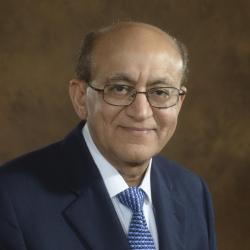
Rakesh Jain, Ph.D.
|
Director Edwin L. Steele Laboratory for Tumor Biology, Massachusetts General Hospital |
|
A. Werk Cook Professor of Radiation Oncology (Tumor Biology) Harvard Medical School |
|
Investigator, Full Prof (M) RadOnc MGH SteeleLabLeadership, Mass General Research Institute |
Research Interests
Research Narrative
As part of the Edwin L. Steele Laboratory for Tumor Biology, research at the Jain Laboratory focuses on normalizing tumor vessels and microenvironment. A solid tumor is an organ composed of cancer cells and host stromal cells, which are nourished by the vasculature and embedded in an extracellular matrix. The interaction among these cells, the surrounding matrix, and the local cellular microenvironment influences the expression of certain genes, whose products control the pathophysiological characteristics of the tumor, govern tumor progression, and affect the tumor's response to various therapies. Blood and lymphatic vessels also serve as conduits for metastatic spread. The over arching goal of our research is to dissect the pathophysiology of the vascular and extra-vascular components of tumors, to determine the role of tumor-host interactions in tumor biology, and ultimately to translate this knowledge into improved cancer detection, prevention and treatment in humans.
To unravel the complex biology of tumors, we have developed an array of imaging technologies, mathematical models and sophisticated animal preparations. These include multiphoton microscopy and genetically engineered mice with surgically implanted transparent windows, which permit the in vivo visualization of gene expression and function in tumors and their surrounding host stroma. This undertaking has provided unprecedented molecular, cellular, anatomical, and functional insights into the vascular, interstitial and cellular barriers to cancer treatment.
Our laboratory found that high interstitial pressure is a universal characteristic of solid tumors, and that it can impair the delivery of molecular medicine within tumors, induce peri-tumor edema and contribute to lymphatic metastasis. We have identified the mechanisms underlying this elevated pressure: high vascular permeability, lack of functional lymphatics, and mechanical stress generated by tumor growth. Overexpression of the lymphangiogenic factor VEGF-C increases lymph node metastasis, but does not increase lymphatic function or decrease the interstitial pressure. However, judicious application of antiangiogenic agents can lower the pressure and improve the delivery and efficacy of various cancer treatments. To gain a deeper insight of tumor microenvironment, we measured interstitial convection, diffusion, and binding using photobleaching, and pO2 and pH profiles around individual tumor vessels using phosphorescence quenching and ratio imaging. We recently proposed the novel hypothesis that the anomalous assembly of the collagen network can prevent the penetration of therapeutic agents in tumors, and showed that the hormone relaxin, bacterial collagenase and MMP1/8 can improve drug distribution by modifying this network.
Our finding that angiogenic molecules regulate adhesion molecules on the vasculature provided the first link between the disparate fields of angiogenesis and adhesion, and revealed a novel mechanism by which tumors evade immune recognition. In collaboration with Dr. Brian Seed, we discovered that cancer cells co-opt the host stromal cells and entice them to produce pro- and anti-angiogenic growth factors. By revealing that host cells are not passive bystanders, but active participants in tumor angiogenesis, growth, metastasis, and therapeutic response, our laboratory provided a rational basis for combining Herceptin with VEGF blockade for the treatment of breast cancer, a concept that led to a clinical trial.
Our work has revealed that the malfunction of the vascular and extravascular compartments in solid tumors often thwarts the effectiveness of both conventional and novel therapies. Our laboratory is most celebrated for a new hypothesis that antiangiogenic therapy can "normalize" the abnormal tumor vasculature and improve both the delivery and efficacy of therapeutics. We have validated this concept in rectal carcinoma and glioblastoma patients receiving antiangiogenic therapy and in the process, discovered potential biomarkers of tumor escape from these therapies. Now we are exploring novel strategies to expand the window of normalization and seeking potential biomarkers for tailoring therapies to individuals.
By integrating principles from physiology, pharmacology, immunology and molecular biology, our laboratory has developed mathematical models of drug delivery and pathophysiological processes in solid tumors. These modeling tools have allowed us to extract simple, important principles that should spark the development of novel diagnostic and therapeutic strategies.
| rjain@mgh.harvard.edu |
| (617) 726-6932 |
|
Cox Building 100 Blossom Street Boston, MA 02114 |
